Brief

In evidenza
- Senior executives at energy and natural resources companies are moving too tentatively to improve sustainability and reduce emissions.
- As the dialogue on climate change intensifies, companies in this sector are coming under greater pressure to reduce their own emissions, as well as those of their suppliers and customers.
- Hesitation stems from concerns about protecting revenues from core activities. But waiting also poses risks, as evidenced by investor sentiment turning away from these sectors.
- Companies should raise their investment in sustainability programs to levels similar to those in other transformation programs: closer to 50%, rather than the 10% currently invested in greening the energy and natural resources sector.
Until very recently, many energy and resource executives believed they could meet sustainability requirements by publicizing a few carefully chosen environmental projects and technology programs. In annual reports and TV ads, these companies have highlighted their successes in, for example, reducing fugitive emissions, developing biofuels and protecting fragile environments—initiatives of which executives can justly feel proud.
But as the climate change dialogue intensifies, and as the calls to take action gain urgency, events are overtaking that traditional, project-by-project approach. For every promotional ad about a company’s efforts to invest in carbon capture or restore wetlands, a million tweets showing a marine animal trapped in plastic make their way around the world and onto the phones of a company’s customers.
Most energy and natural resources CEOs would say that their companies have accelerated their sustainability efforts (see Figure 1). But many would also admit that they have fallen behind in this first round of discussion with their stakeholders and customers, who have different expectations about the speed and scale of response. As students take to the streets on climate strike Fridays, customers demand greener products, lawmakers press industry for action and investors begin to demand more accountability. Utilities, agriculture, mining, chemicals and oil and gas companies find themselves on the back foot, with the stakes rising ever higher and the recognition that their asset value and social license to operate may be at risk.

These companies do not lack the organizational expertise to change how they operate. But they are limited by their own definitions of their businesses and the narrow range of their strategic goals. For most, the goal has always been to deliver an ever-increasing output—whether oil, gas, chemicals, electricity, raw materials or food—safely and at the lowest cost. Doing so in an entirely sustainable way that incorporates responsible consumption and waste management, all with a target net-zero carbon footprint, was not part of the mandate—until now.
Their traditional approach risks stranding resource producers in increasingly defensive and reactive positions, with a dwindling amount of time to deliver change and little opportunity to differentiate themselves from competitors. Instead, leadership in the sector will increasingly demand strategic thinking about resources, from production through end use and beyond. Too few companies are stepping up to the challenge; most are investing no more than 10% of their capital in programs to become more sustainable and carbon-neutral.
It’s not enough: Any other corporate ambition intended to fundamentally shift a company’s direction would start by investing at least 30% of new capital to build sufficient scale and momentum, eventually committing more than half of new investment capital in the new direction.
The argument for a cautious approach rests on the need to maintain returns from the traditional core. But there is also risk in waiting too long. As disruptive technology advances, capital remains abundant and sentiment shifts, first movers are likely to see greater returns. Already, companies such as Neste and Ørsted are enjoying strong shareholder support as they build scale in renewables and biofuels. Those slower to move, with average to poor operational capability, can always expect a rough ride.
Raising aspirations
Within the energy sector, power utilities appear to have made the greatest sustained push and set the boldest ambitions (see Figure 2). Bain research finds that among major utilities in Europe and North America, new capital expenditure on greener investments ranged from 15% to 47% of total spending over the past three years. Globally, investment in renewable power generation outstrips investments in fossil fuels and nuclear power combined, and renewables now account for more than a third of global power-generation capacity. Some leaders are pushing the envelope. Enel wants to become entirely carbon-neutral by 2050, and Duke Energy has committed to cutting carbon emissions in half by 2030 and operating at net-zero carbon levels by 2050.
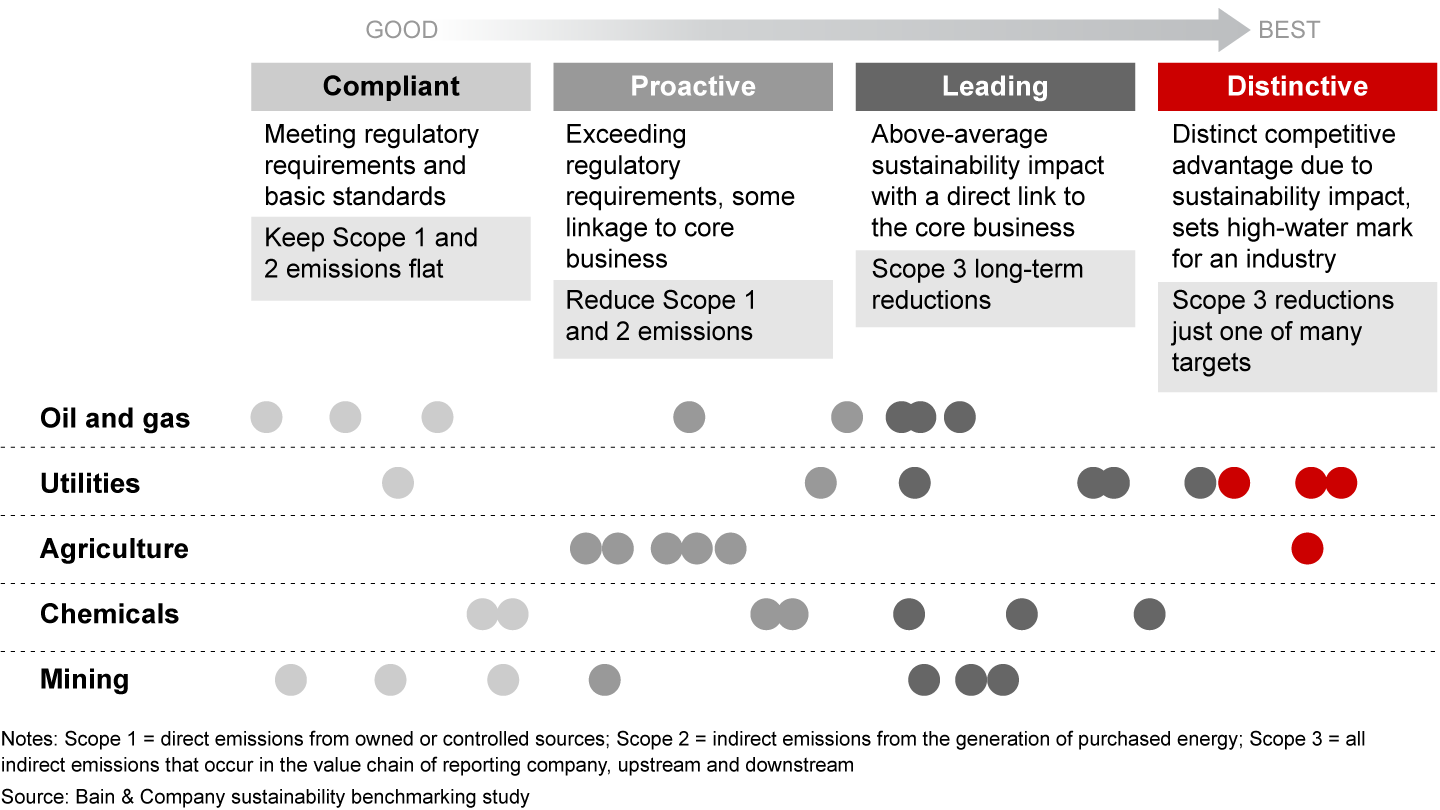
Mining and oil and gas companies are also raising their sustainability ambitions, but investment to date has been limited. One example of an ambitious commitment is BHP’s recent announcement that it would take a $780 million write-down to switch from coal to a power-purchase agreement based on renewables at its Chilean copper operations.
Chemicals and agricultural strategies tend to focus on enabling customer sustainability through product development and adhering to the principles of circularity, which reduces waste. They see greater potential there than in simply transforming their own operations, which has been an area of historical focus. Major chemical companies such as BASF have pushed hard to improve energy efficiency in operations and are now steering R&D spending toward biofeedstock, recycling, lighter-weight materials and battery technologies. Upstream agricultural providers like Nutrien and Syngenta are investing in ways to boost productivity, limit land use and promote biodiversity at farms
In the oil and gas industry, Repsol’s commitment to becoming a net-zero company by 2050, including its production and the emissions from its products, stands out. Finnish oil refiner Neste’s repositioning of its portfolio to green products and Danish energy company Ørsted’s divestment of oil and natural gas resources in favor of wind power demonstrate investor appetite to support these more radical moves.
These industry sectors may be at different starting points, but they all face a steep climb. And they need a program that sets a sturdy foundation for significant change, one that lays out a roadmap to raise urgency and activity to meet expectations.
Bain's Jenny Davis-Peccoud explains the six "next practices" that companies can take to develop a truly sustainable economy.
Setting a foundation for progress
Taking responsibility for one’s own consumption, waste and emissions is a start. But true sustainability leadership entails becoming a steward of resources throughout the value chain. Senior executives who truly understand their own business will need to adopt principles of a circular economy, widening their frame of responsibility to include upstream suppliers and downstream customers and across sectors. They will become champions of innovation with economic and ecological benefits within a full-cycle resource system that includes waste and recycling. And they will use their capabilities and assets not just to invest directly in change, but also to mobilize larger pools of capital.
The prospect may seem overwhelming, but executives can begin laying a foundation by focusing on three strategic actions.
- Set a guiding ambition. CEOs of energy and resource companies are increasingly being asked where they are taking the company on sustainability. Institutional investors, who are themselves under pressure to adopt a more environmentally friendly portfolio, want to understand the sustainability ambitions of the companies they invest in. So it is essential to be able to describe the path you are taking—not necessarily in great detail, but by setting expectations and establishing a positive change trajectory.
However, that is not the only reason to set a clear ambition. Big companies tend to perform better with a clear, top-down framework that helps the business set its priorities and agenda. Given their starting positions, no energy or resource company could hope to switch to a more sustainable model without clear direction from the top ranks that can then systematically be driven across the portfolio.
It may be easiest to think about setting the ambition as a three-part process (see Figure 3). First, top executives need to understand the baseline—where are we starting from? Second, how does that compare with others in our business, and what can we learn from industry benchmarks? Finally, the result of these first two steps should point to untapped, game-changing opportunities: what is possible in the short and medium term, rather than just the long term?
As with a continuous improvement program, ambition and goals will need to be reevaluated and improved as companies learn more, technology improves and conditions change. Executives will discover that it is possible to go further faster than they had originally anticipated.
Figure 3Sustainability strategy focuses on bold, resilient moves and risk management on priority topics including carbon emissions 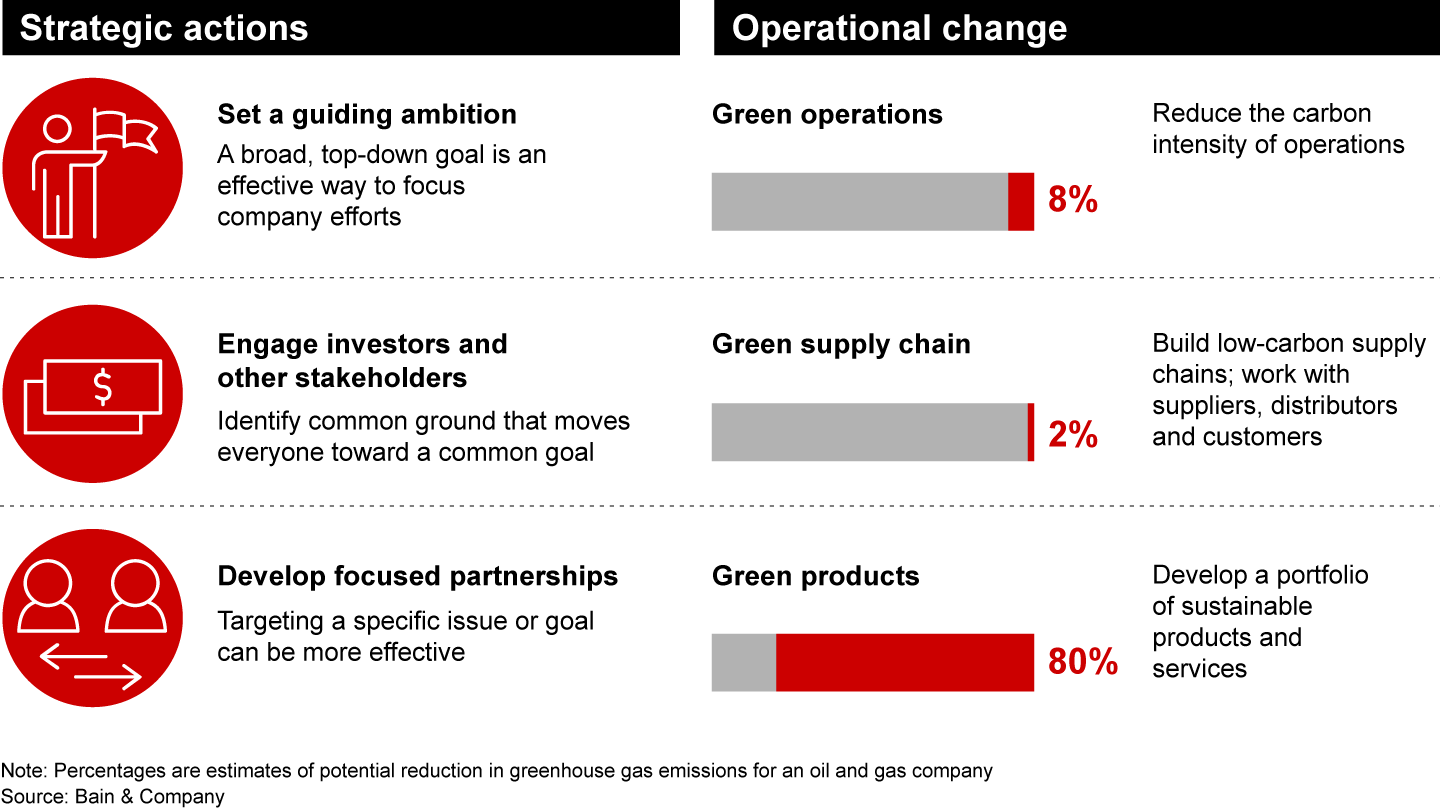
- Engage investors and other stakeholders. As stakeholders become more sophisticated and better equipped to participate in discussions about sustainability, the level of engagement is shifting (see Figure 4). The debate is no longer about this or that initiative, but rather the entire structure and purpose of the organization, as well as its direction.
It is also, increasingly, about cooperating with stakeholders to identify common ground that moves everyone toward the goal of, for example, reducing carbon emissions. If the relationship among stakeholders remains adversarial, everything will be difficult. Executives, board members and shareholders have a large role to play in nurturing these new relationships and enabling change.
Figure 4Institutional investors who have approved more climate proposals hold smaller investments in energy and natural resources 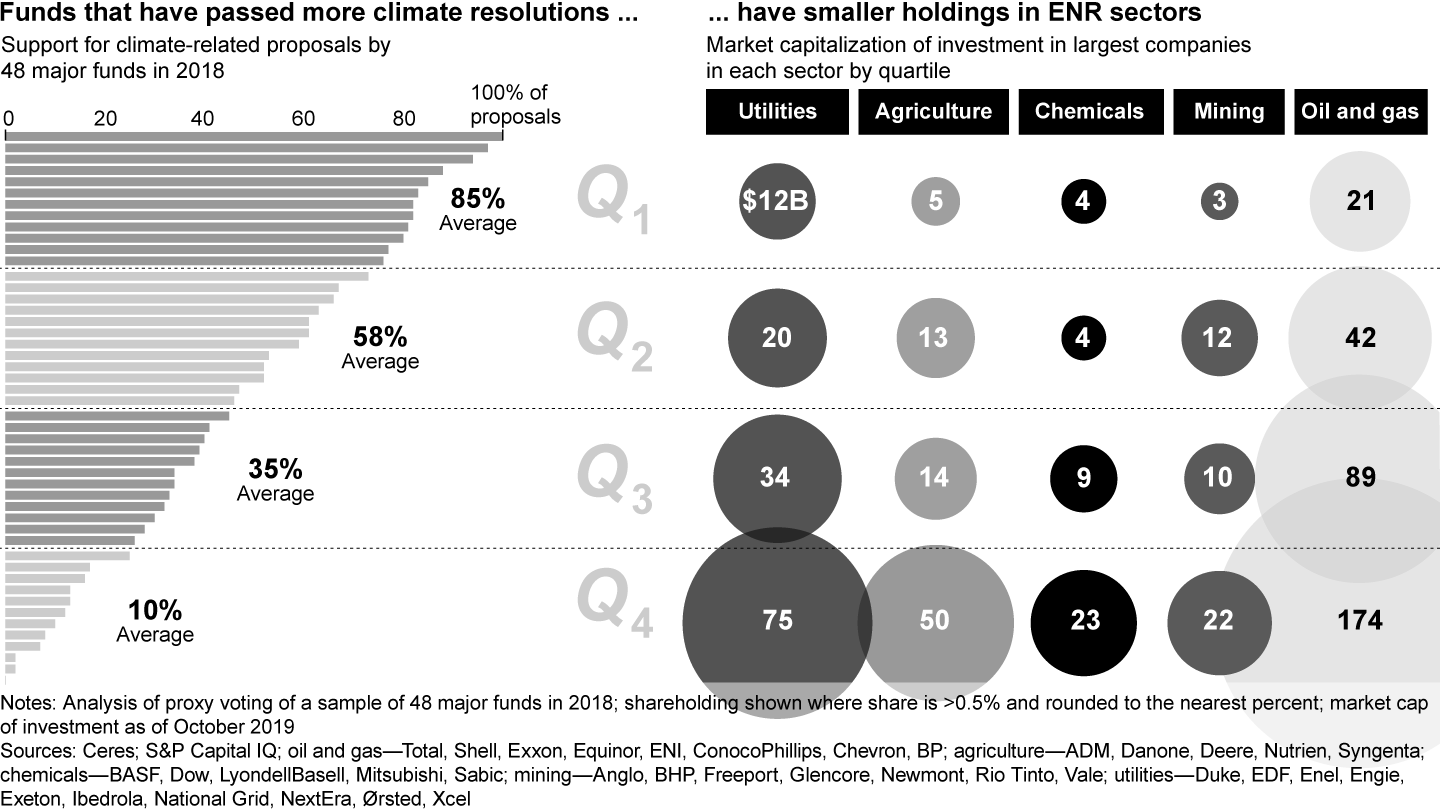
- Develop focused partnerships. Companies in the energy and resource sector have a track record of working closely together to develop new projects, technologies and processes, as a way to spread risk. Finding a single industry direction on sustainability may be more difficult because the rules and metrics are not yet commonly recognized and written down. Organizations do not know where they are headed or how much they will change.
Because companies are starting from differing baselines and aspirations, effective partnerships are likely to focus on solutions to specific problems. The Alliance to End Plastic Waste, a coalition of chemicals and consumer products companies, is one example. Similarly, the Oil and Gas Climate Initiative brings together 13 international and national oil companies to target three objectives: reducing energy use in the supply chain, accelerating low-carbon solutions and enabling a circular carbon model.
Operational change
When energy and resource companies turn to the operational aspects of sustainability, most find they can accomplish quite a bit in a short amount of time. The same capabilities that contribute to excellence in such areas as operations, manufacturing and supply chain can also be applied to reducing energy use, curbing emissions and minimizing waste. The transformation is not unlike the digital transformations at their organizations over the past decade—new processes that talented engineers are often very enthusiastic to apply and can be scaled up to benefit the entire organization. If the goal is to reduce emissions, companies can launch initiatives on three dimensions.
- Reduce the carbon intensity of operations. Many of the quick wins of sustainability occur first in operational efficiency, making this a logical area of focus. Since no single company is embarking on this journey alone, an entire sector can learn from the experience. Within operations, three levers offer the greatest potential for reducing carbon intensity: avoidance, carbon capture and offsets. Generally, these levers can support about 25%, 40% and 35% of the challenge, respectively.
But as with cost reductions or digital advances, companies also can gain a competitive edge by identifying proprietary processes that deliver products and services with a lower carbon footprint. What is the advantage? Assuming all other properties are equal, the greener product may emerge the winner in the coming marketplace (see Figure 5).
Oil and gas producers are under pressure to reduce operational CO2 and other greenhouse gas emissions across the global supply curve toward the goal of net zero 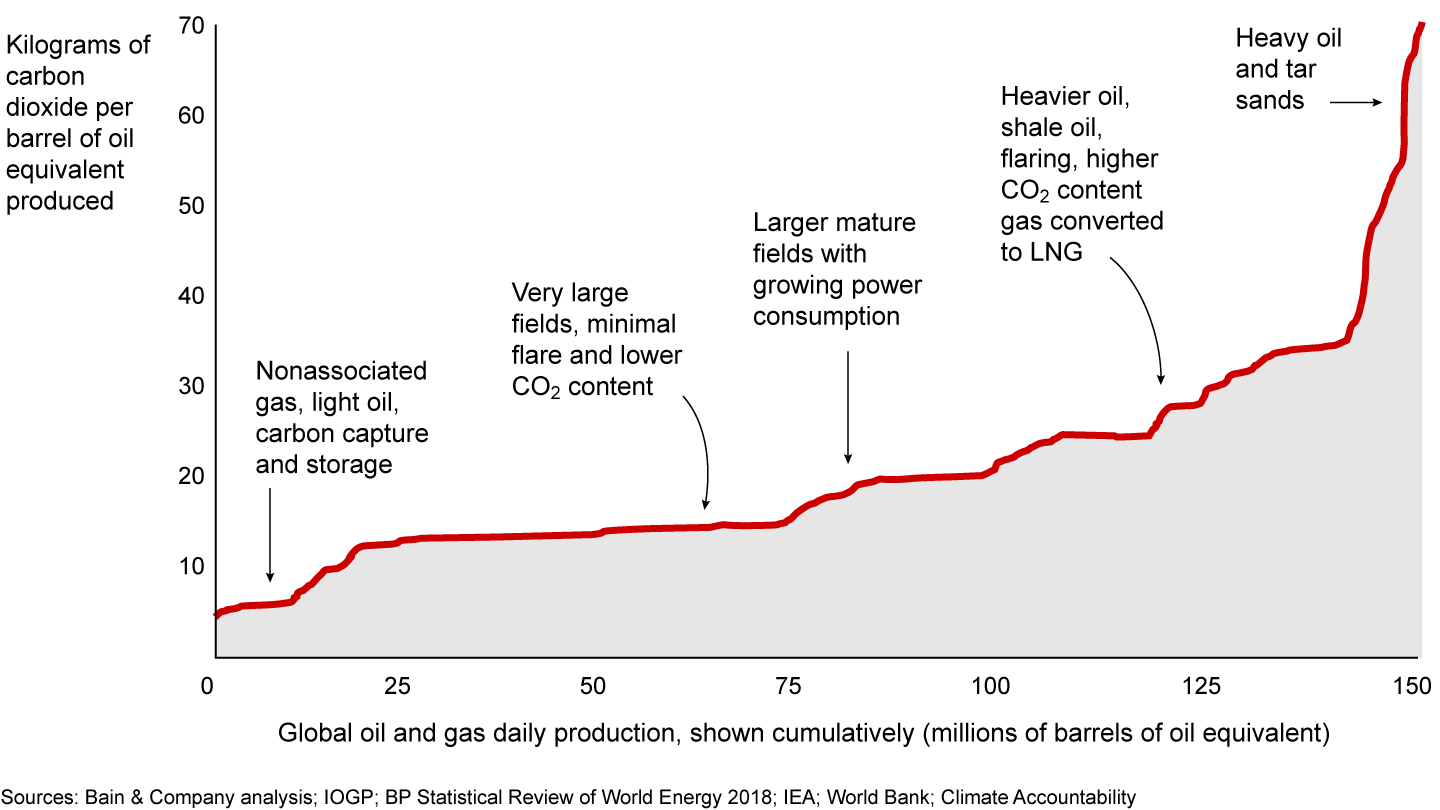
- Shrink the carbon footprint of the supply chain. Companies can reduce the carbon output of their own operations and still have very little impact on the cumulative footprint of their products. They will need to work with suppliers, distributors and customers to improve sustainability, renegotiating and, when necessary, shifting to suppliers of different products and practices. In oil and gas, the supply chain can provide as much as 10% of operational improvement opportunities, and in other sectors, the supply chain may emit more greenhouse gases than the company itself does.
- Develop a portfolio of sustainable products and services. Over the long term, executives need to rebalance their traditional product lines and create new products that are less carbon-intensive for end users. For oil and gas companies, these new products may include alternative fuels. In chemicals, companies are already hard at work to make plastics that are more recyclable and less likely to be discarded after a single use. Utilities have been shifting investment to renewable power generation, large-scale battery storage, and more efficient transmission and distribution systems.
Three key themes will shape the redefinition of product lines:
- Circularity. How much of what we produce comes back to the producer or can otherwise be reused rather than falling out of the value cycle as waste?
- Changing the mix. How can we use different materials that allow us to make products with less carbon or waste? How can we design products that are easier to recycle or reuse?
- Responsible packaging and end use. Beyond the creation of the product, how can it reach its end user with less waste? Can the consumer easily manage the waste that results from its use?
As the global population approaches 9.7 billion by 2050, much of that growth will be in emerging markets, where energy and natural resources companies are likely to encounter their greatest sustainability challenges. Developed markets in the US and Europe are converging on some sustainability issues: increasing regulatory pressure, actively engaged consumers and robust innovation ecosystems that can bring solutions to scale quickly. Emerging markets face more challenging issues as they try to raise sustainability levels while managing their economies, population growth, and deficiencies in skills and infrastructure.
In these markets, energy and natural resources companies can play a significant role in sustainability, just as they did in industrialization. Utilities can make commitments to support energy access and affordability, while investing in renewables and distributed energy. Agricultural companies can provide small farms with more sophisticated offerings, such as traceable products to improve source tracking. And companies in oil and gas and chemicals can pool resources to tackle some of the most stubborn problems, including plastic waste and greenhouse gas emissions.
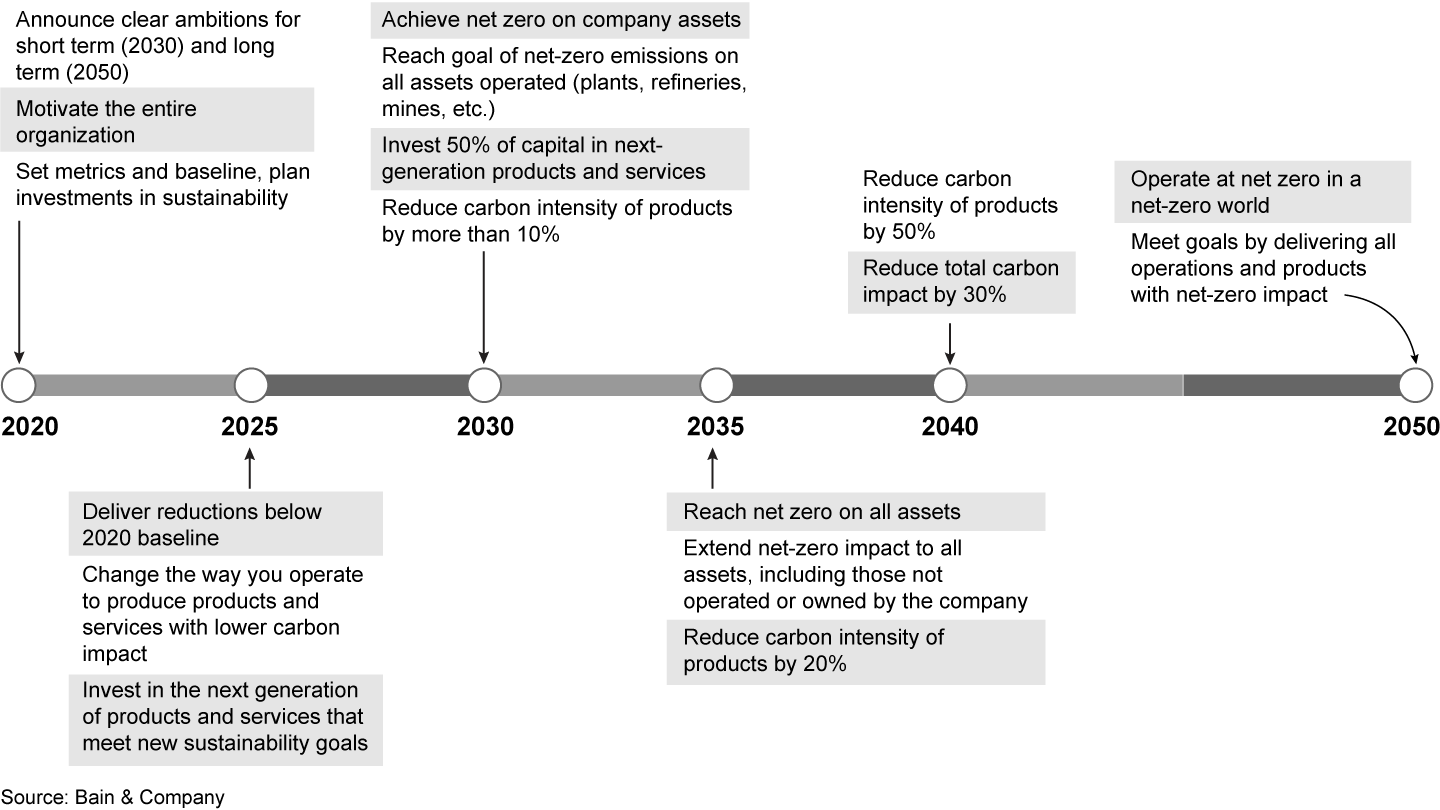
Creating a progressive, compelling roadmap will help companies, customers and shareholders focus their efforts, and will deliver tangible progress in shifting from resource production to resource stewardship (see Figure 6). The path to sustainability for energy and resource companies promises to be narrow and fraught with challenges and setbacks. But so, too, was their path to industrial and economic success. When have such odds ever dissuaded ambitious and determined executives or the companies they lead?
Peter Parry leads Bain & Company’s Global Oil & Gas practice, and Dave Rennard is a principal in Bain’s Energy & Natural Resources practice. Peter is based in Milan, and Dave is in London.






